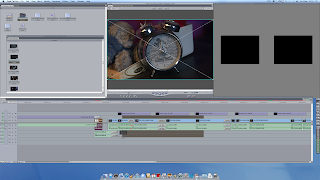Question 5 - How did you attract/address your target audience?
I think mise-en-scene is the best aspect of our opening. For example, the use of action/mystery in our opening appeals to our audience because it immediately engages them with the plot and encourages them to follow the film.
Thinking back to our rough-cut feedback, we were initially without titles or a soundtrack, so incorporating that into our final-cut was a major improvement and ultimately, the reason behind the success of our film. We also used various editing-transitions to make the jump between shots appear 'seamless', a match cut if you'd prefer.
Though a good film should contain good camera-work, quality sounds, sharp editing and clear mise-en-scene, I think this is not the key element that attracts an audience (excusing the trailer). I believe it is the syndication behind it. We've created a Facebook page, Twitter and YouTube accounts so we could post trailers and interviews with the actors, starring in the film. Now, In a parallel universe, I'm sure Cara's an B-list celebrity but for the purpose of this evaluation, she is one. This'll make viewers want to watch their favourite actors, no matter what genre of film it is.
We've posted the 3-minute opening for our film on Vimeo and are currently awaiting collective criticism before proceeding to showing this film in cinemas.
I also decided to do a 'Q&A Sunday' with an actor from the film - Brian Fissler - in which the public get to ask him questions in regards to my hectic promotional schedule and all the PR he's been doing.
For anyone un-able to understand/hear him. Here's a printed scrip of the video:
Hi guys, and for any of you forced by their kin to watch this and you don't quite know who I am, I am Brian Fissler, minor actor and brother to the very talented director Anthony Fissler, I told him I do this Q&A session for anyone interest in this film. So let's get started!
[Q: What have you been doing to advertise this film]
- So far, I've been doing interviews with independent film sites such as Radience.org and IndieWire.com. We talk about the film's synopsis and working behind the stuff. There's some stuff said about Cara, the lead actor on there that may be inappropriate for me to say, right now. I suggest you check it out!
[Q: Has it been a hectic experience, so far?]
- Definitely, but that's the film industry for you. Any advice for those interest in film-making. The amount of dedication you put into advertisement and so, is really is how commercially successful you'll be.
[Q: I've seen the film-opening. It was really good. Was this really the right thing to do?]
- Firstly, thank you for your kind words, the team behind Pathogen appreciate any kind of feedback we can get. Secondly, seeing as the people at DAK Pictures are new to the film industry, it was only right that they see what viewers like yourself thought of the opening. After all, our film isn't your generic action-thriller-film. But, personally, I think that makes for a better film.
[Q: What are the plans for the future?]
- Well, after this Q&A, I'm off to the Cineworld at The O2 where an exclusive screening of Pathogen'll take place. After that, there's scheduled to be another Q&A session with me and the writers. For anyone London-based, with nothing to do this bleak-looking Sunday. Please, get yourself to North Greenwich and watch our full-feature.
Unfortunately, that's all I have time for but you'll be able to follow me on Twitter @FisslerLAD where I'll be tweeting the progress from the film. As ever, I enjoy hearing your feedback and I hope you enjoy the rest of your day. Thank you for watching!















































